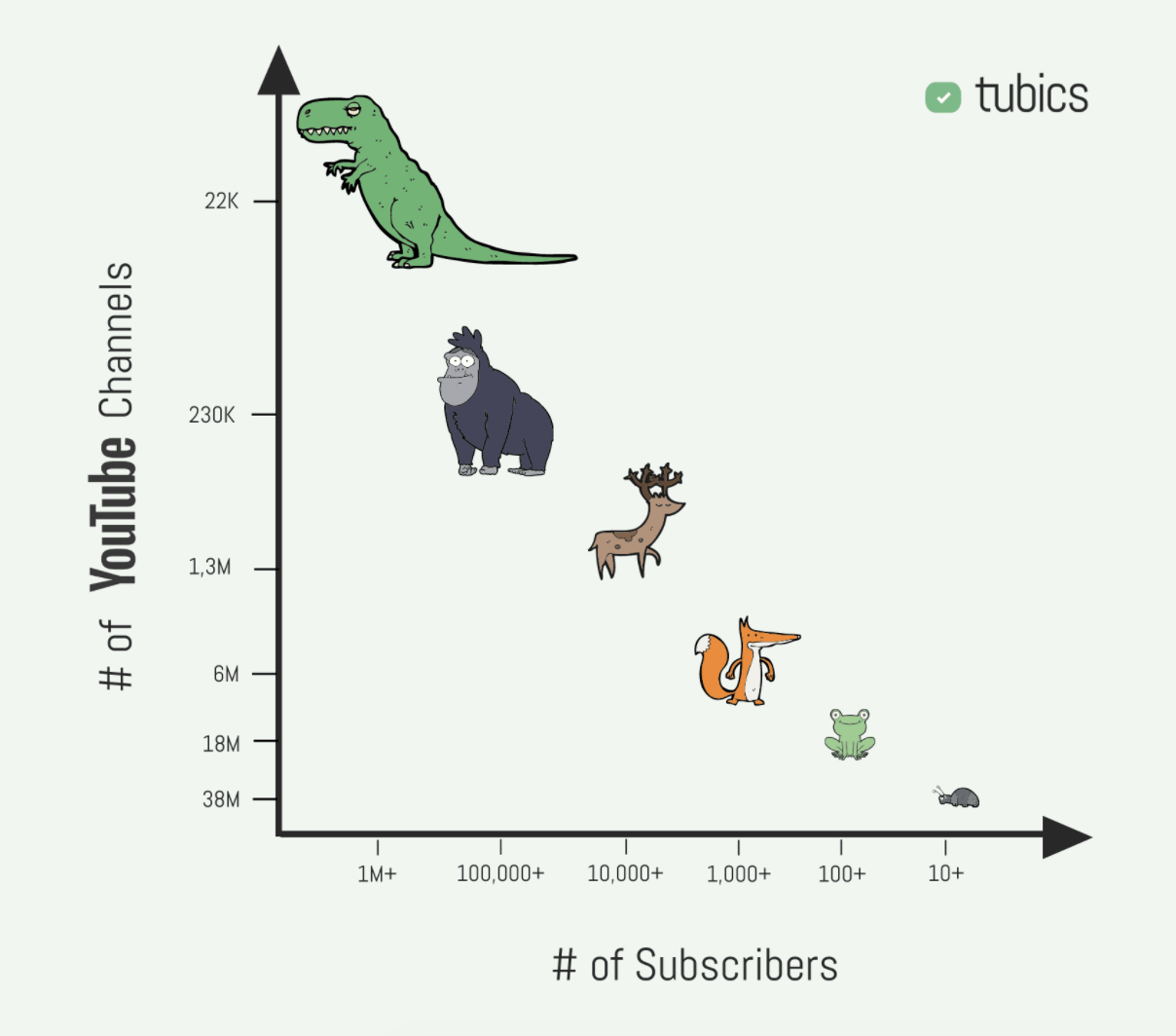YouTube is your landlord
Why are content creators renting space from YouTube when they should be going owning the distribution of their content?
There are more than 22 thousand YouTube channels with over 1 million subscribers. Over the last four years (2016 to 2020), the number of YouTube channels with at least 1 million subscribers went from 2,000 to 22,000. Eleven-fold growth in 4 years. Alright, you get the point. Content creators with sizable audiences are emerging every day with followings larger than an average primetime TV show (which is about 500K viewers).
Crude estimates tell us that the average YouTuber with 1 million subscribers takes home about $57,000 a year from YouTube ad revenue. That number seems small to me too. But, even if the real average is closer to $570,000 a year, YouTubers are missing out on a lot of potential earnings.
Ad-Based Revenue Model vs Premium Subscription Model
Let’s take a look at some anecdotal evidence, shall we? Dear reader, this next part is in no way meant to get your over-stimulated political juices flowing. It just happens to be one of the cleanest examples of switching from a renting-space-on-YouTube ad revenue model to an Owned Media model or a premium subscription-based model.
This particular content creator was demonetized on YouTube forcing him into an Owned Media premium content model. This makes it clean and easy to figure out roughly how much he was making before and after so we can compare both strategies.
Key Assumptions:
Forbes estimates that Google pays YouTubers a $5 CPM or $5 per 1000 views. SocialBlade estimates $.25 — $4 CPM, Influencer Marketing estimates between $3–$5 CPM. I will use the highest estimate, $5 CPM.
HypeAuditor’s calculator estimates how much money on average a particular YouTube channel makes per video. I will use this estimate for a secondary check.
Ad-Based Revenue Model: $233,600/year
Using $5 CPM: $233,600 in annual revenue Gavin Mccinnes's channel has: [128K views per video] X [$5 CPM] X [365 videos per year] = $233K per year.
HyperAudit Estimate: $125,195 in annual revenue [$343 estimated earning per video] X [365 videos per year] = $125K per year.
Using the highest CPM I could find from a reputable source, McInnes’s channel used to rake in about $233,600 per year from YouTube ad revenue. Let’s take a look at what happened when he stopped posting his content on YouTube and went behind a paywall.
Premium Subscription Model: $1,600,000/year
As of April 2020, McInnes claimed to have 16,000 paying subscribers on his private video network, Censored.tv. The subscription is $10/month or $100/year (with discount). Simple math tells us that his channel is now making $1.6 million a year compared to the $233 thousand he was making under a YouTube ad-based model.
His annual revenue grew by 584% simply by switching from an ad model to a premium subscription model. That is ridiculous growth with virtually the same content strategy and volume.
Over the past year, McInnes would post short clips of some of his content to YouTube as free advertising to attract more potential fans to his premium site. Or, at least he was until he was completely kicked off YouTube while this article was being written. The larger point is that creators using a paywall subscription model can and should still use YouTube and other public platforms as a means of lead generation to something that is owned by the content creator (i.e. a premium subscription site). Rethinking YouTube as a free advertising platform instead of a monetization tool can lead to 5x growth in revenue will using virtually the same content.
Gavin only had 376K followers on his YouTube channel. Imagine how much money he could be making if he had nearly 3x that and was in the 1MM subscriber club along with 22,000 other YouTubers.
16,000 out of his 376,000 YouTube subscribers converted to be paying subscribers. That is a 4.2% conversion rate. This seems high. Patreon estimates about 1% of your fans will become paying fans. However, this doesn’t take into account what might happen when 90% of your best content is behind a paywall, or what might happen when the fan's experience is better than what YouTube provides for free.
Assuming his conversion rate was only 1%, Gavin would still come out ahead. At a 1% conversion rate, Gavin would be generating $376,000 per year which is still a 61% increase in revenue compared to a YouTube ad model.
Why aren’t more creators putting their best stuff behind a paywall?
Is the technical implementation too much of a challenge?
Is it simply a fear of losing their audience if they ask them to pay? (In the example above, McInnes did have the benefit of telling his audience he had no other choice thanks to YouTube banning him).
Are influencers making up the difference with sponsorship deals and merchandise lines?
Are creators more concerned with fame, influence, and reach than they are with increasing their income?
Tell me, tell me! email me: patrick@pattynever.com or Tweet at me @Patty2bc
Perhaps a distinction should be made between the different types of YouTubers. For example, gamers that can easily pump out content have a greater potential for ad revenue because of their high-volume content production style, while low-volume, high-quality production might be better suited for a paywall.
Final Thoughts
Once a content creator owns their distribution, not only can they charge more for their content but they can also offer a more intimate experience to their fans. Online retail has already seen this revolution take place as more eCommerce brands are putting a larger emphasis on growing their Shopify storefront instead of their Amazon marketplace presence. Will the same happen in the new media industry?
Beyond the simple superior economics of a subscription-based model, are YouTubers missing out on an opportunity to create a more robust experience for their fans with an Owned Media model?
Email: Patrick@PattyNever.com | Twitter: @patty2bc

